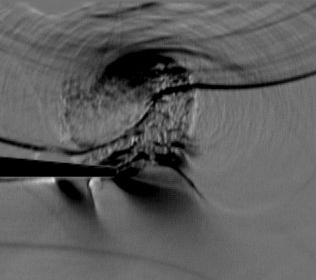Shock Wave Diffraction Phenomena around Slotted Splitters †
Abstract
:1. Introduction
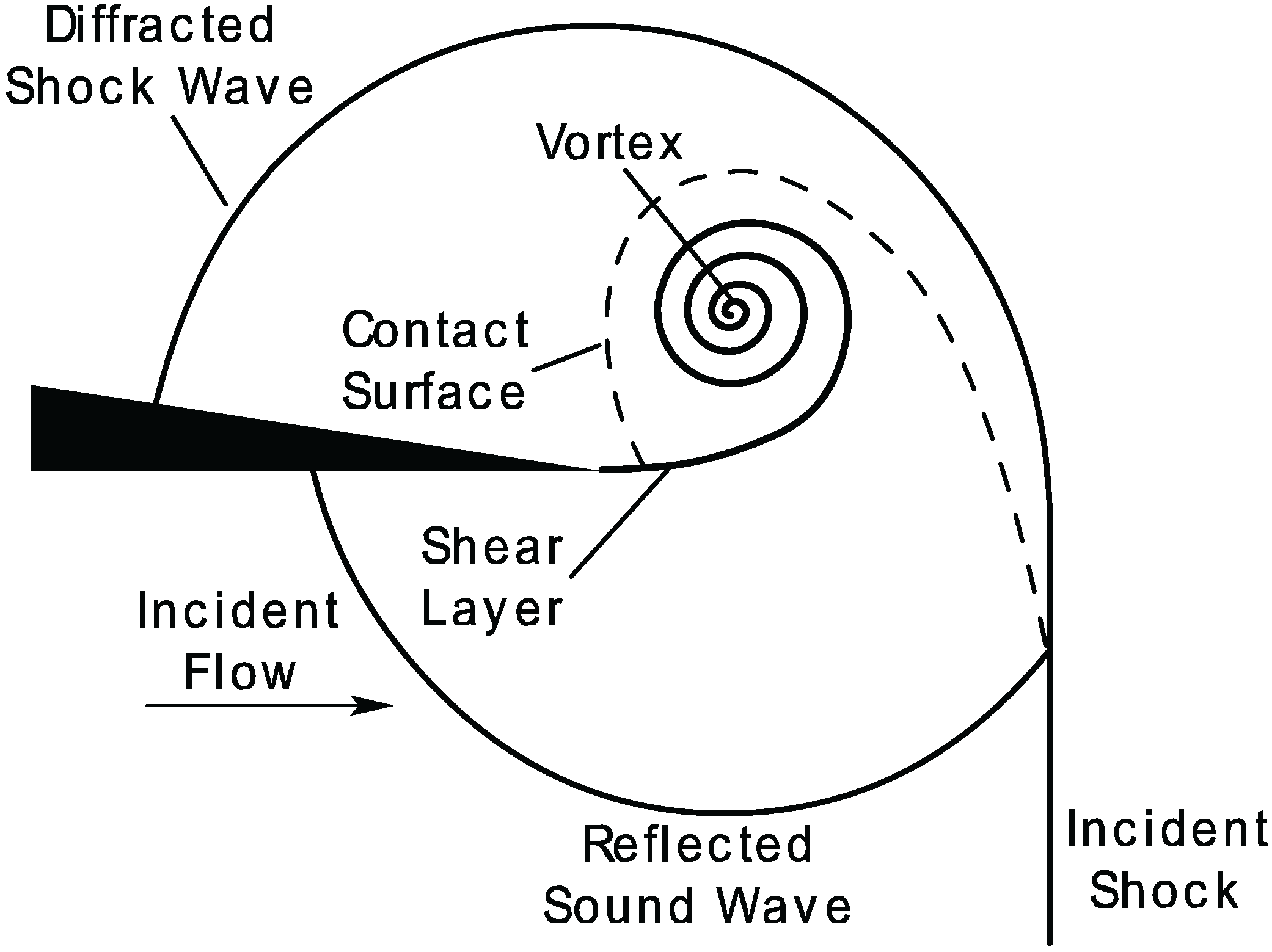
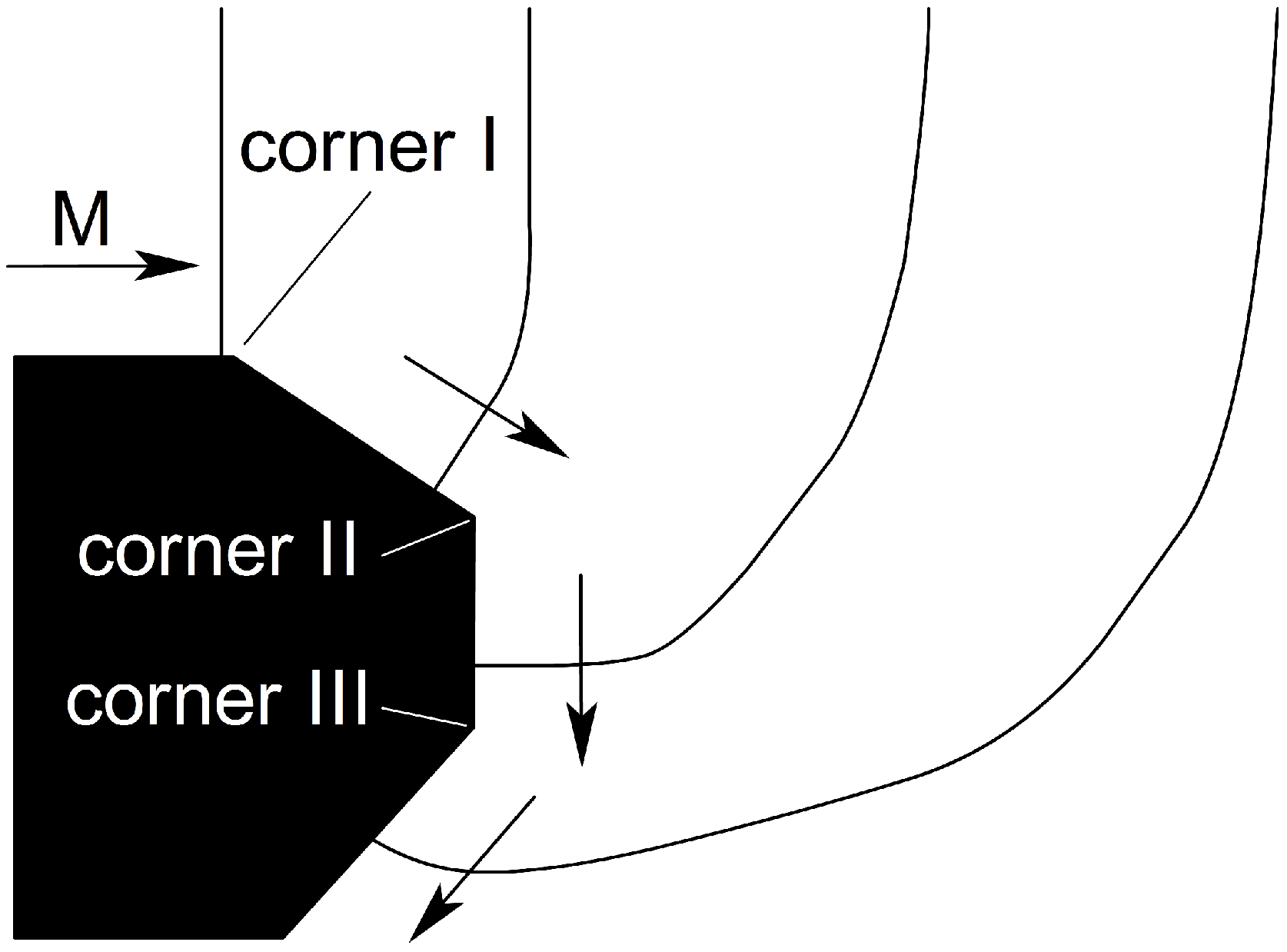
2. Experimental Section
2.1. Shock Tube and Test Section Models

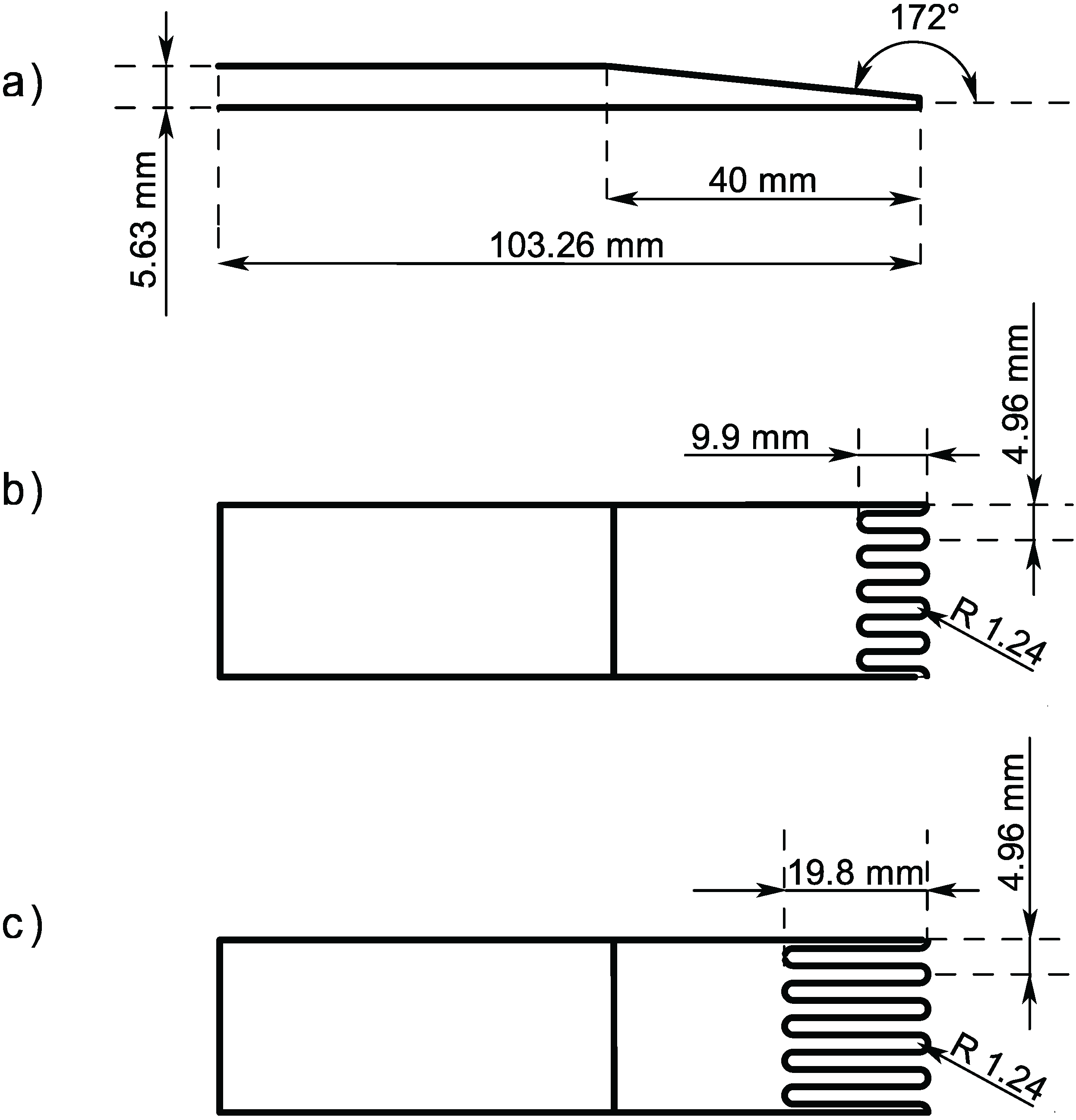
2.2. Schlieren

3. Results and Discussion
3.1. Mach Number of 1.31
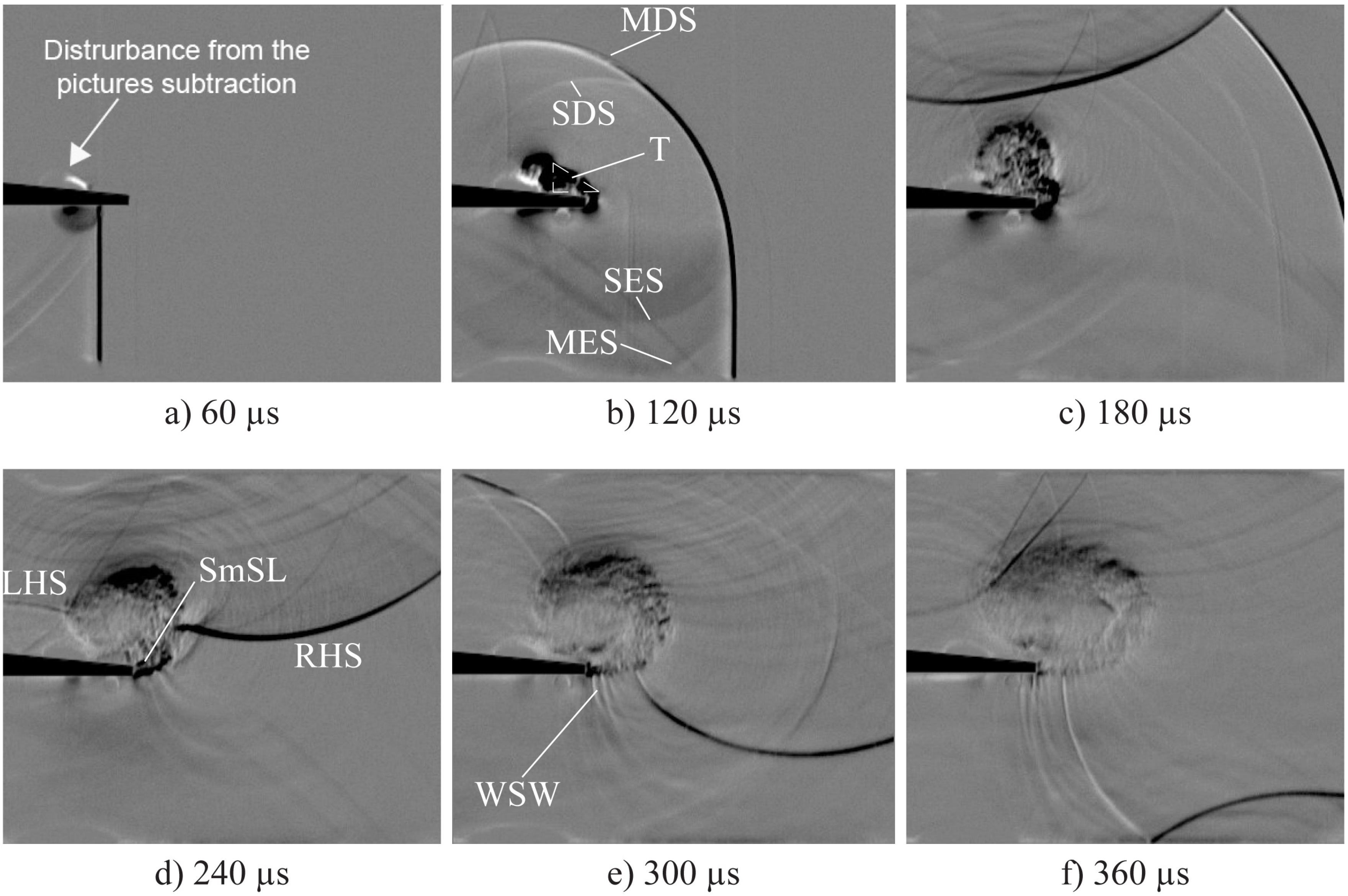
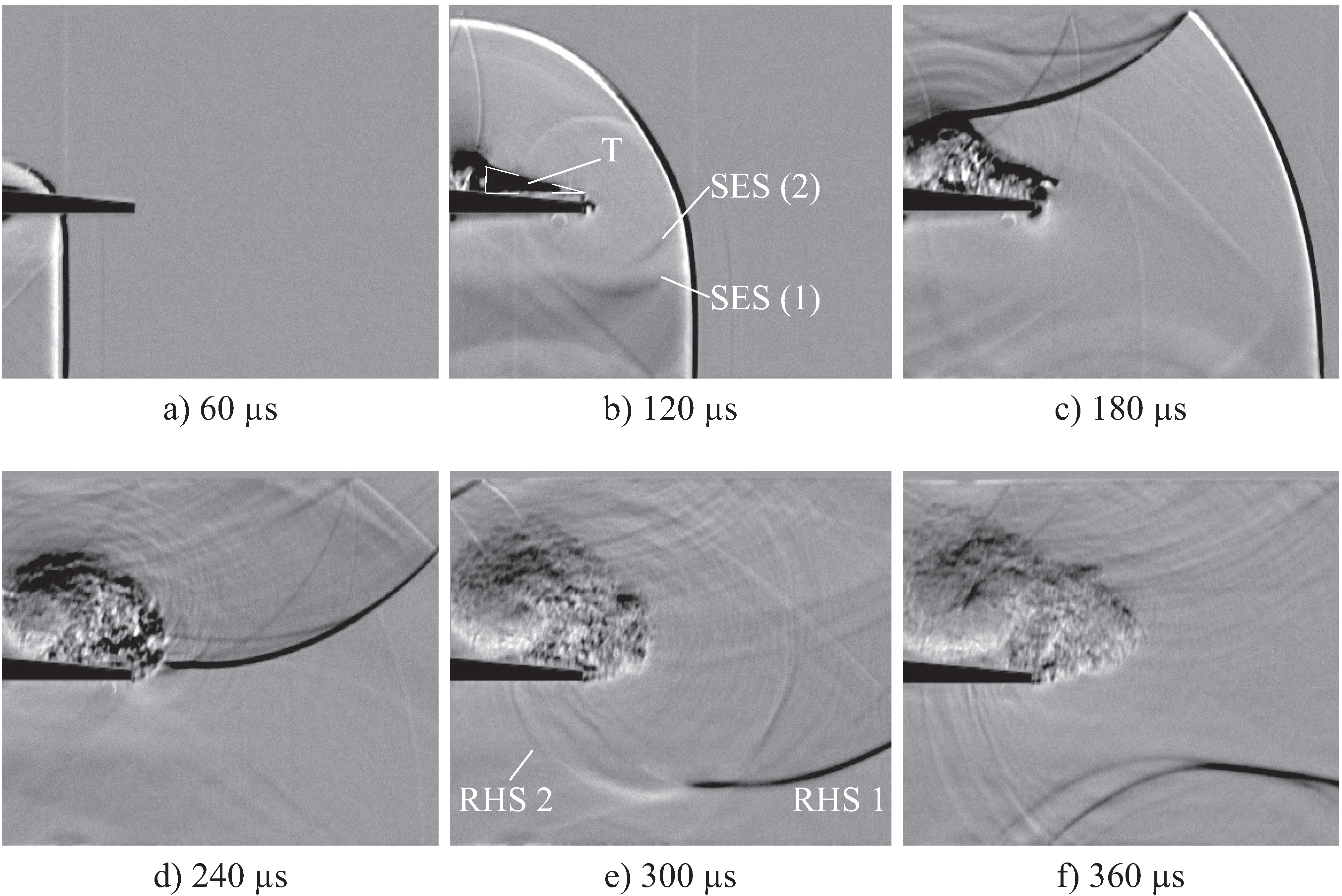
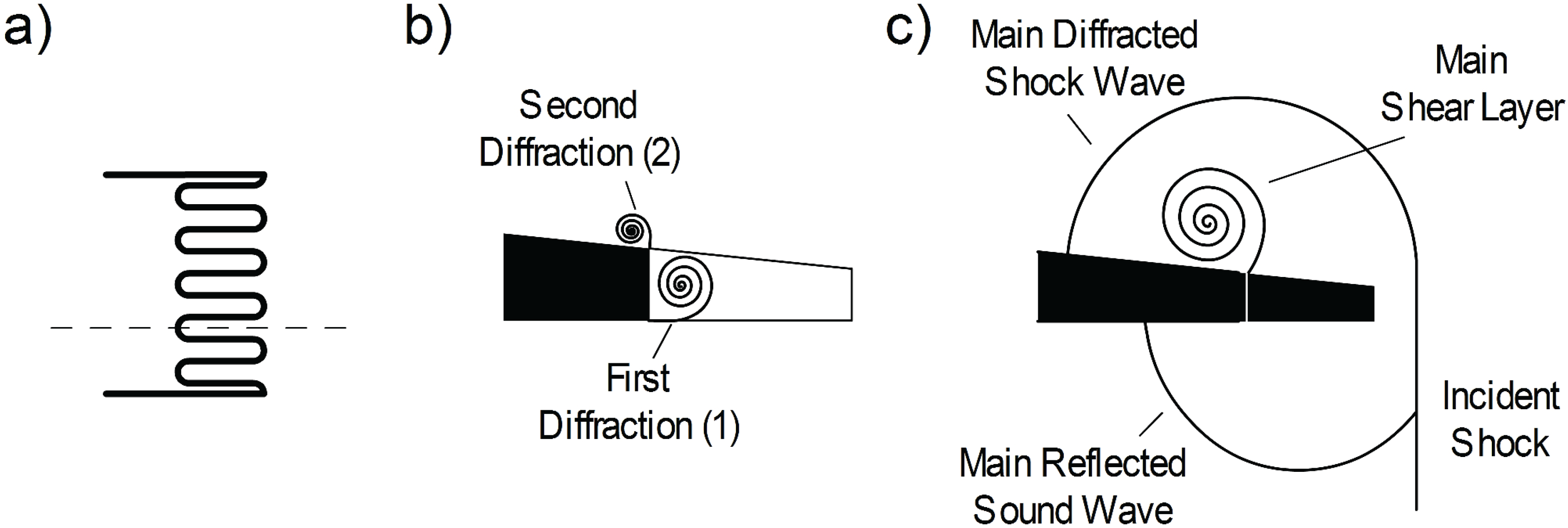

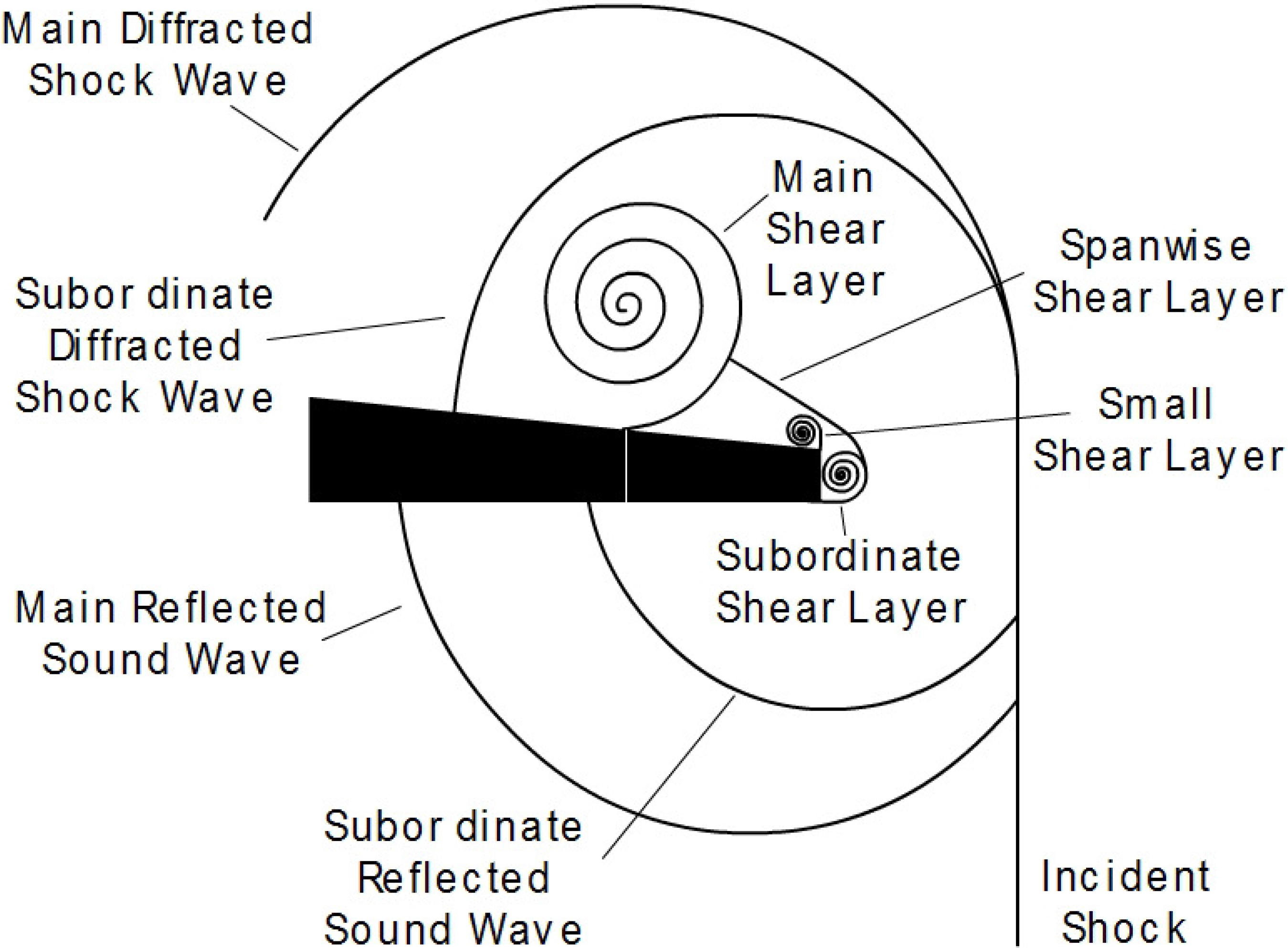
3.2. Mach Number of 1.59
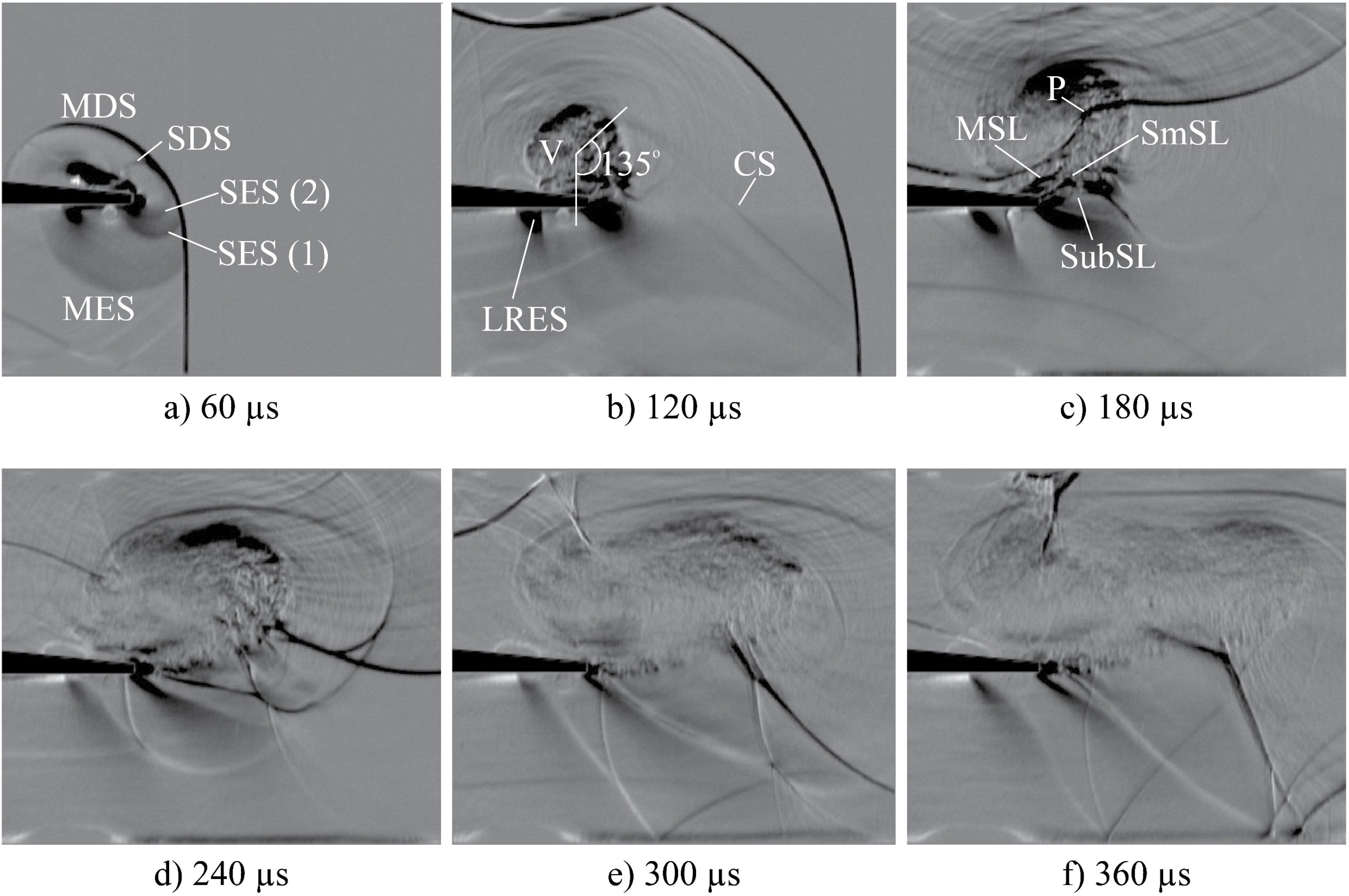
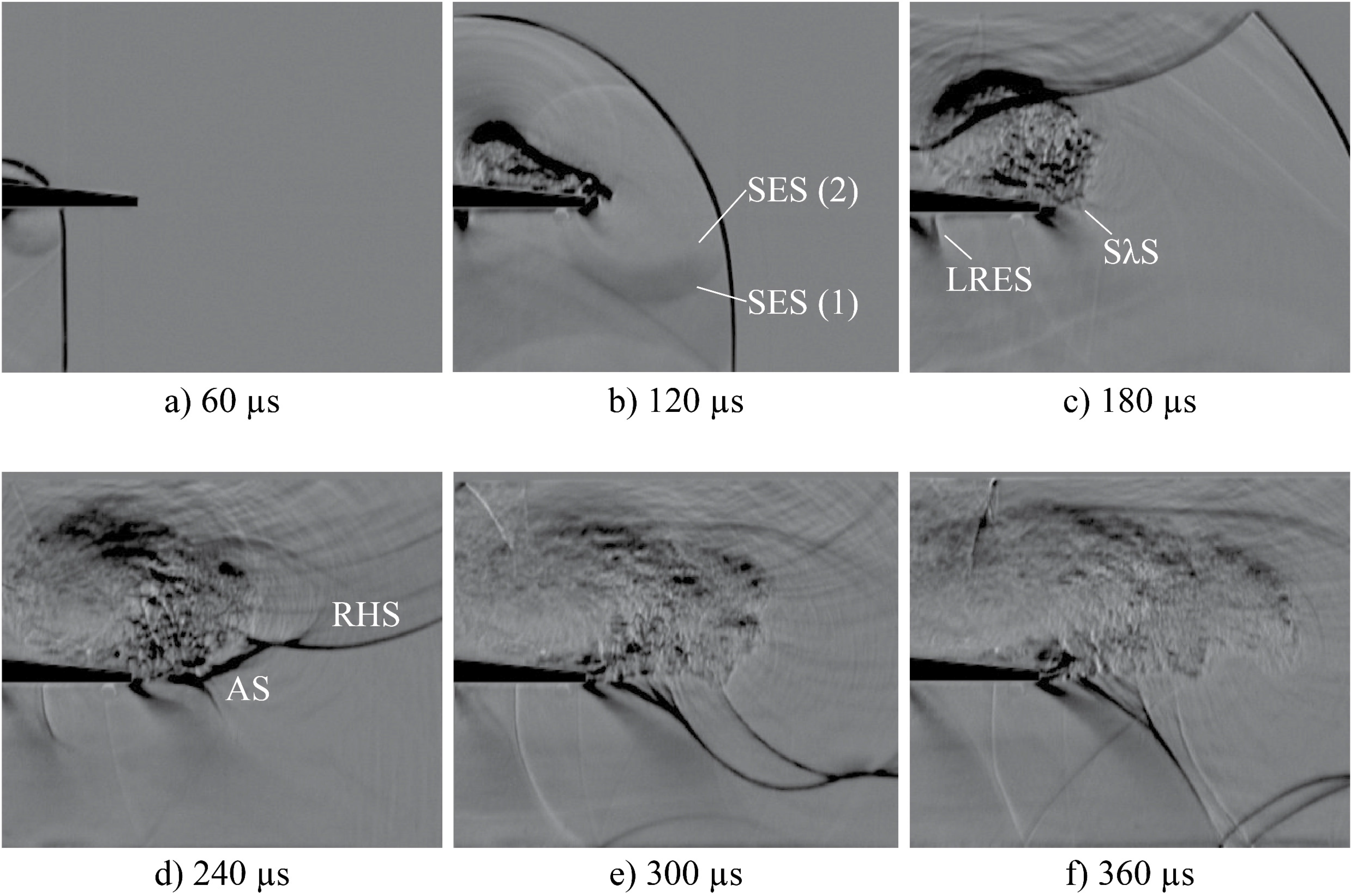

4. Conclusions
Acknowledgments
Author Contributions
Nomenclature
| AS | Arc of shock |
| CS | Contact surface |
| LHS | Left-hand side shock wave |
| LRES | Last running expansion shock wave |
| MDS | Main diffracted shock wave |
| MES | Main expansion shock wave |
| MSL | Main shear layer |
| RHS | Right-hand side shock wave |
| SDS | Subordinate diffracted shock wave |
| SES | Subordinate diffracted expansion shock wave |
| SmSL | Small shear layer |
| SubSL | Subordinate shear layer |
| SλS | Lambda shocklet structure |
| T | Triangular shape |
| V | Vortex |
| WSW | Weak sound waves |
Conflicts of Interest
References
- Skews, B.W. The perturbed region behind a diffracting shock wave. J. Fluid Mech. 1967, 29, 705–719. [Google Scholar] [CrossRef]
- Skews, B.W.; Law, C.; Muritala, A.; Bode, S. Shear layer behavior resulting from shock wave diffraction. Exp. Fluids 2012, 52, 417–424. [Google Scholar] [CrossRef]
- Bazhenova, T.V.; Gvozdeva, L.G.; Nettleton, M.A. Unsteady interactions of shock waves. Prog. Aerosp. Sci. 1984, 21, 249–331. [Google Scholar] [CrossRef]
- Abate, G.; Shyy, W. Dynamic structure of confined shocks undergoing sudden expansion. Prog. Aerosp. Sci. 2002, 38, 23–42. [Google Scholar]
- Lighthill, M.J. The diffraction of blast I. Proc. R. Soc. Lond. A 1949, 198, 454–470. [Google Scholar] [CrossRef]
- Skews, B.W. The shape of a diffracting shock wave. J. Fluid Mech. 1967, 29, 297–304. [Google Scholar] [CrossRef]
- Henderson, L.F. Regions and boundaries for diffracting shock wave systems. Z. Angew. Math. Mech. 1987, 67, 73–86. [Google Scholar] [CrossRef]
- Bazhenova, T.V.; Gvozdeva, L.G.; Zhilin, Y.V. Change in the shape of the diffracting shock wave at a convex corner. Acta Astronaut. 1977, 6, 401–412. [Google Scholar] [CrossRef]
- Srivastava, R.S. On the vorticity distribution over a normal diffracted shock for small and large bends. Shock Waves 2012, 23, 525–528. [Google Scholar] [CrossRef]
- Whitham, G.B. New approach to problems of shock dynamics, Part II: Three-dimensional problems. J. Fluid Mech. 1959, 5, 369–386. [Google Scholar] [CrossRef]
- Jones, D.S.; Whitham, G.B. An approximate treatment of high-frequency scattering. Proc. Camb. Philos. Soc. 1957, 53, 691–701. [Google Scholar] [CrossRef]
- Li, H.; Ben-Dor, G.; Han, Z.Y. Analytical prediction of the reflected-diffracted shock wave shape in the interaction of a regular reflection with an expansive corner. Fluid Dyn. Res. 1994, 14, 229–239. [Google Scholar] [CrossRef]
- Skews, B.W. Shock wave diffraction on multi-facetted and curved walls. Shock Waves 2005, 14, 137–146. [Google Scholar] [CrossRef]
- Quinn, M.K. Shock Diffraction Phenomena and Their Measurement. Ph.D. Thesis, University of Manchester, Manchester, UK, 2013. [Google Scholar]
- Sun, M.; Takayama, K. Vorticity production in shock diffraction. J. Fluid Mech. 2003, 478, 237–256. [Google Scholar] [CrossRef]
- Quinn, M.K.; Kontis, K. A combined study on shock diffraction. In Proceedings of the 5th Symposium on Integrating CFD and Experiments in Aerodynamics, Tokyo, Japan, 3–5 October 2012.
- Quinn, M.K.; Kontis, K. Experiments and simulations of weak shock wave diffraction phenomena. In Proceedings of the 20th International Shock Interaction Symposium, Stockholm, Sweden, 20–24 August 2012.
- Reeves, J.O.; Skews, B.W. Unsteady three-dimensional compressible vortex flows generated during shock wave diffraction. Shock Waves 2012, 22, 161–172. [Google Scholar] [CrossRef]
- Sun, M.; Takayama, K. A note on numerical simulation of vortical structures in shock diffraction. Shock Waves 2003, 13, 25–32. [Google Scholar] [CrossRef]
- Sun, M.; Takayama, K. The formation of a secondary sock wave behind a shock wave diffracting at a convex corner. Shock Waves 1997, 7, 287–295. [Google Scholar] [CrossRef]
- Bazhenova, T.V.; Bulat, O.V.; Golub, V.V.; Shul’meister, A.M. Three-dimensional diffraction of a shock wave. Fluid Dyn. 1993, 28, 153–154. [Google Scholar] [CrossRef]
- Zare-Behtash, H.; Gongora Orozco, N.; Kontis, K. Effect of primary jet geometry on ejector performance: A cold-flow investigation. Int. J. Heat Fluid Flow 2011, 32, 596–607. [Google Scholar] [CrossRef]
- Zare-Behtash, H.; Kontis, K.; Gongora Orozco, N.; Takayama, K. Shock wave-induced vortex loops emanating from nozzles with singular corners. Exp. Fluids 2010, 49, 1005–1019. [Google Scholar] [CrossRef]
- Barbosa, F.J.; Skews, B.W. Shock wave interaction with a spiral vortex. Phys. Fluids 2001, 13, 3049–3060. [Google Scholar] [CrossRef]
- Ferri, A. Review of scramjet propulsion technology. J. Aircr. 1968, 5, 3–10. [Google Scholar] [CrossRef]
- Gongora-Orozco, N.; Zare-Behtash, H.; Kontis, K. Global unsteady pressure-sensitive paint measurements of a moving shock wave using thin-layer chromatography. Measurement 2010, 43, 152–155. [Google Scholar] [CrossRef]
- Zare-Behtash, H.; Kontis, K.; Gongora Orozco, N.; Takayama, K. Compressible vortex loops: Effect of nozzle geometry. Int. J. Heat Fluid Flow 2009, 30, 561–576. [Google Scholar] [CrossRef]
- Gongora-Orozco, N. Experimental Studies on Internal Shock Wave Phenomena and Interactions. Ph.D. Thesis, University of Manchester, Manchester, UK, 2010. [Google Scholar]
- Onodera, H.; Takayama, K. Interaction of a plane shock wave with slitted wedges. Exp. Fluids 1990, 10, 109–115. [Google Scholar] [CrossRef]
- Skews, B. Shock wave interaction with porous plates. Exp. Fluids 2005, 39, 875–884. [Google Scholar] [CrossRef]
- Ellzey, J.L.; Henneke, M.R.; Picone, J.M.; Oran, E.S. The interaction of a shock with a vortex: Shock distortion and the production of acoustic waves. Phys. Fluids 1995, 7, 172–184. [Google Scholar] [CrossRef]
- Dosanjh, D.S.; Weeks, T.M. Interaction of a starting vortex as well as a vortex street with a traveling shock wave. AIAA J. 1965, 3, 216–223. [Google Scholar] [CrossRef]
- Chang, S.M.; Chang, K.S.; Lee, S. Reflection and penetration of a shock wave interacting with a starting vortex. Phys. Fluids 2004, 42, 796–805. [Google Scholar] [CrossRef]
- Chang, K.S.; Chang, S.M. Scattering of shock into acoustic waves in shock-vortex interaction. Mater. Sci. Forum 2004, 465–466, 131–138. [Google Scholar] [CrossRef]
- Mahomed, I.; Skews, B.W. Diffraction of an expansion wave around a 90°. In Proceedings of the 29th International Symposium on Shock Waves, Madison, GA, USA, 14–19 July 2013.
© 2015 by the authors; licensee MDPI, Basel, Switzerland. This article is an open access article distributed under the terms and conditions of the Creative Commons Attribution license (http://creativecommons.org/licenses/by/4.0/).
Share and Cite
Gnani, F.; Lo, K.H.; Zare-Behtash, H.; Kontis, K. Shock Wave Diffraction Phenomena around Slotted Splitters. Aerospace 2015, 2, 1-16. https://doi.org/10.3390/aerospace2010001
Gnani F, Lo KH, Zare-Behtash H, Kontis K. Shock Wave Diffraction Phenomena around Slotted Splitters. Aerospace. 2015; 2(1):1-16. https://doi.org/10.3390/aerospace2010001
Chicago/Turabian StyleGnani, Francesca, Kin Hing Lo, Hossein Zare-Behtash, and Konstantinos Kontis. 2015. "Shock Wave Diffraction Phenomena around Slotted Splitters" Aerospace 2, no. 1: 1-16. https://doi.org/10.3390/aerospace2010001






